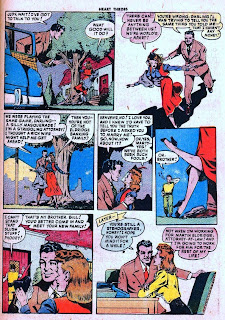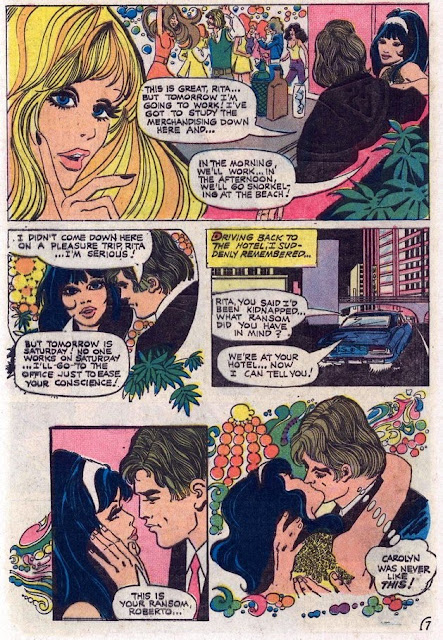The assumption of superiority that accompanies wealth appears to be a barrier that Mona uses, in this case, to avoid confronting her true feelings regarding Bill. Those feelings become evident to Mona later in the story when the yacht is in trouble in a Caribbean storm. Mona sees Bill injured and instinctively goes to his rescue while putting her own safety in danger. Its also a new side of Mona that Bill hadn't known existed, and its enough to tip the scales in his heart towards declaring his love for Mona.
What we don't see is Mona's father's reaction to this union. Will he suspect Bill of using his daughter to get at the Barclay fortunes? Will Mona really be able to cope with such a drastic reduction in household income if she and Bill live true to the statement that they'll manage on a sailor's wages? The cultural differences between the two are likely to create distance in a number of areas of their marriage. But the story's author stops at the point where everything's really hunky dory, without troubling our minds with worries about what might not work out.
Another story in the same comic, "Double Masquerade", is a version of the gold digger story mentioned above. Judy is an office worker, a typist, fed up of existing in the lower socio-economic stratum of society. She's saved up a bunch of money, bought herself some great clothes, and she's off to stay at a swanky country retreat, Lakeshore Manor, where she fully admits she will make every attempt to find herself a well-to-do husband. Very similar to the Girls' Love Stories 147 plot. At the Manor she plays it cool, then the opportunity for a handsome gentleman to step in is provided by Judy's horse bolting. It looks to Judy like everything's going according to plan.
They fall in love, but Judy has to repeatedly avoid Marty's questions about her family. Judy doesn't want to let go of him, believing him to be a member of a wealthy banking family, but her love for him is real, and her conscience won't let her go through with the charade. She fesses up to Marty that she's just a poor stenographer, but runs off too soon for Marty to tell her it doesn't matter 'cause he's from the lower echelons of society himself. Marty's persistence catches him up to her where they can both come clean about their masquerade and their true feelings for each other. They can both live with their failed ambitions to become rich by tricking the other because they've found something more. And don't you think their comparable backgrounds will assist in allowing them to make a good go of their marriage?
Then I took a look at the second story in Intimate 1 (Charlton Comics, December 1957), entitled "Late Love". This is a 5-page short story highlighting awareness amongst the impoverished of how financial difficulty places additional stressors on a marriage, putting it at greater risk of failure. So accepting of this principle was Carmen, that she never entertained the idea of marrying the man she'd loved since high school, because he couldn't provide the financial security she required to make her feel that her future marriage would succeed.
Carmen turns down Brick Howell's proposal's of marriage, telling him straight it's because he's poor. She doesn't count the acreage his grandfather left him as worth anything, but Brick has faith that one day, as the area develops, his plot will be sought after and worth a bundle. Carmen dates one guy after another, but can't connect with them because she's in love with Brick. She finally gets a handsome, rich guy, Clay Mason, interested in her, and mentally prepares herself to settle down with him. But seeing Brick brings it all back to her, and she knows he's the only one for her. She gives up her requirement for her man to be rich, and agrees to marry Brick. Just then Clay turns up, steps aside seeing that Carmen obviously adores Brick, and announces that he's just purchased Brick's land for a tidy sum. So Carmen gets her financial security after all - if only she'd had more faith in Brick's vision, they could have been together all this time. Still, better late than never. Again, though, this story brings up the issue of wealth, in this case being the concern of a woman requiring monetary assets as a precondition of marriage. Strangely enough, this behavior is supported by research that shows women are more attracted to guys with money, while men are more interested in a woman's looks, and its all very Darwinian and down to what's going to produce offspring most likely to survive. So when romance comics incorporate these societal stereotypes (comic book writers pull ideas from, for example, existing media or simply from life itself) there's a lot to the stories in terms of giving us glimpses of patterns in human behavior. Comic book - 10 cents. University research - thousands of dollars. Hmmmm...!




























































